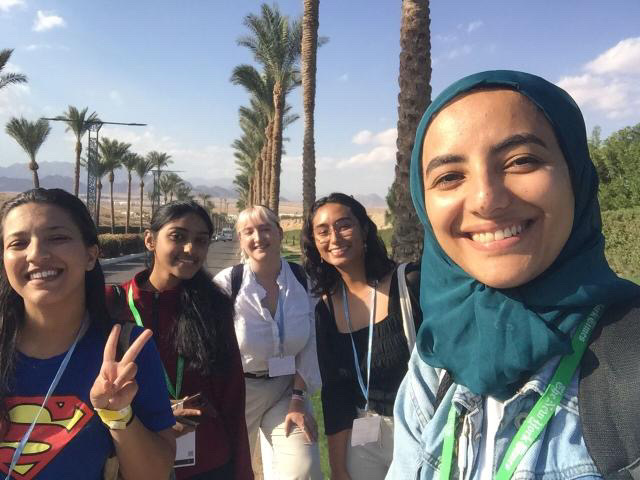By Mika Alexander
In all honesty, I was nervous walking into COP27. Despite knowing I would be engaging in an international space, I arrived hyper-aware of my position as a woman of color surrounded by high-level negotiators, many of whom are elder men.
For context, I am pretty used to my existence remaining unacknowledged in all types of spaces, particularly those in which I am in the minority. As such, I have been pushed to the periphery in intimate conversations in which I am the only person of color. In these conversations, I brace myself to be ignored by others’ eye contact and not be asked for my name. So, I expected many of my interactions at the conference to unfold similarly. Spending much of my time during this past week at the New York Times Climate Forward program, however, I came to be pleasantly surprised.
The three-day-long program is held outside of the blue zone, which is where the official negotiations and presentations of COP27 occur. Each speaker session hosts engaging conversations in the form of panel discussions, debates, and fireside chats. Additionally, the speakers represent various backgrounds from youth activists, Indigenous voices, scientists, and business owners to political figures. Almost every session left a few minutes at the end to take questions from the audience.
On the first day, a blank notepad and wooden pencil sat atop each seat in the audience. According to each session’s moderator, audience members were to write questions using the notepads before passing them off to various “mic runners” throughout the room.
Right away, my head was swarming with questions after listening to the first discussion. The topic “On the Verge of Progress: Where will COP27 Take Us?” ignited a fiery excitement throughout the presentation room, and I felt the energy of curious COP observers, learners, and activists almost breaking pencils as people around me passionately scribbled questions onto their notepads.
With only a handful of minutes left at the end of the first session for questions, the moderator called on two white men to ask questions.
It was frustrating to see, but I figured maybe they just beat everyone else to turn in their questions.
Meeting the handfuls of young women, many of whom were women of color, in the restroom during the session’s subsequent coffee break made me realize my frustration was valid. As soon as I stepped inside, I could hear my young peers talking about how none of their questions were chosen. Sensing a similar feeling of disappointment among them, I introduced myself and explained how I also had a question that was overlooked.
Despite all of us coming from different national, cultural, and linguistic backgrounds, we immediately hit it off as we gave each other supportive fist bumps and cracked jokes about the question-answer system being “rigged.”
Of course, we had no evidence of any rigging, but the jokes we made with each other seemed to help us reconcile the sinking feeling many women of color, especially young women of color, feel as their thoughts, questions, and overall learning are ignored. Plus, after hearing the speakers during the opening remarks and first session rave about the powerful presence of youth voices, it was amusing and surprising to be overlooked in that way.
On a more uplifting note, my interaction with the group of girls in the restroom gave me the confidence to ask another question during the next session. This time, my name was called, and I was able to engage the panelists in a way that felt empowering to me and my learning. Across other sessions, I saw other young women and women of color stand up to ask their own respective questions as well, each prompting a thoughtful response from the speakers.
Seeing this progression was inspiring, to say the least. It felt great to see that none of us were totally discouraged from asking more questions and putting ourselves out there. Maybe they meant nothing, but I like to think that the interactions we had with each other in the restroom only helped further empower us to continue to question and learn. So, I am thankful for the New York Times Climate Forward event’s ability to create a space for young women to be able to empower each other in this way.
I could talk for ages about what I experienced at the venue over the past three days. However, I felt it most important to first highlight how conducive the space was to fulfilling the reason I even came to COP27 at all: to learn, engage, and feel involved in tangible steps to lessen the climate crisis while creating community with like-minded youth.
